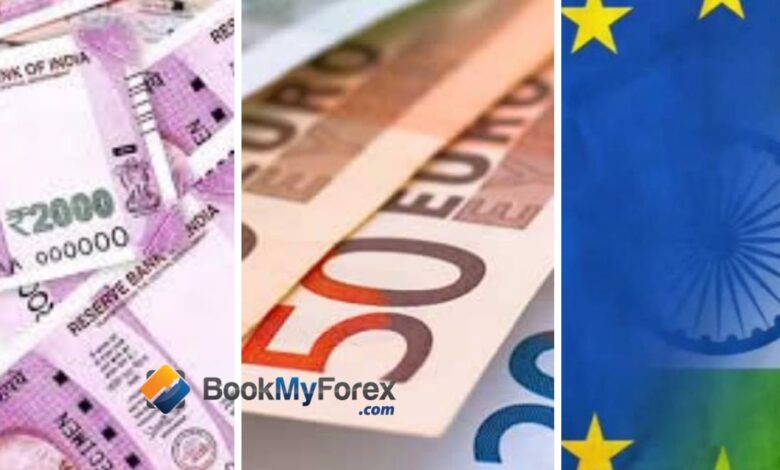A Comprehensive Guide to Understanding the Euro to INR Exchange Rate
A Comprehensive Guide to Understanding the Euro to INR Exchange Rate

The Euro to INR exchange rate is a crucial indicator that impacts various aspects of the global economy, from import and export figures to tourism and foreign direct investment. Keeping track of the exchange rate can help businesses make informed decisions and individuals plan their finances efficiently.
In this guide, we’ll delve into the factors influencing the Euro to INR exchange rate, such as economic indicators, government policies, and market forces. Additionally, we’ll explore the historical trends and patterns, as well as provide tips on how to find the best rates for your currency exchange needs.
So, whether you’re a business owner looking to optimize your foreign transactions, or someone planning a trip to Europe, this guide is designed to provide you with the insights necessary to understand and navigate the Euro to INR exchange rate effectively. Let’s dive in!
Factors Influencing the Euro to INR Exchange Rate
The exchange rate between the Euro and the Indian Rupee (INR) is influenced by various factors. Understanding these factors can help you anticipate and make sense of currency fluctuations. One of the primary factors that impact the exchange rate is the relative strength of the economies of the Eurozone and India.
Economic indicators, such as GDP growth, inflation rates, and interest rates, play a significant role in determining the exchange rate. A strong economy with high growth rates and low inflation is likely to attract foreign investors, which can increase the demand for the currency and drive up its value. On the other hand, a weak economy with low growth rates and high inflation may lead to a decrease in currency value.
Government policies also have a significant impact on the exchange rate. Central banks, including the European Central Bank (ECB) and the Reserve Bank of India (RBI), use monetary policy tools to influence interest rates, money supply, and exchange rates. For example, if the ECB decides to increase interest rates, it can make the Euro more attractive to investors, leading to an appreciation of the currency.
Market forces, such as supply and demand dynamics, also play a crucial role in determining the exchange rate. Factors like trade imbalances, capital flows, and investor sentiment can affect the demand for and supply of currencies, leading to fluctuations in exchange rates. For instance, if there is an increase in demand for Indian goods and services in the Eurozone, it can lead to an increase in the demand for the Indian Rupee, thereby appreciating its value.
Understanding these factors can help individuals and businesses make informed decisions regarding currency exchange. By keeping an eye on economic indicators, government policies, and market trends, you can anticipate currency fluctuations and plan your transactions accordingly. Additionally, staying updated with global news and events can provide valuable insights into potential shifts in the exchange rate.
Historical Trends and Patterns of the Euro to INR Exchange Rate
Examining the historical trends and patterns of the Euro to INR exchange rate can provide valuable insights into the currency’s behavior and help anticipate future movements. Looking back at the exchange rate over a specific period can reveal patterns and trends that can be useful for making informed decisions.
Over the past decade, the Euro to INR exchange rate has shown both volatility and stability. During periods of economic uncertainty, such as the global financial crisis in 2008, the Eurozone debt crisis in 2011, and the COVID-19 pandemic in 2020, the exchange rate experienced significant fluctuations. These events highlighted the importance of monitoring the exchange rate and managing currency risk.
However, there have also been periods of relative stability, where the exchange rate remained within a narrow range. During these times, factors like stable economic growth, balanced trade, and favorable government policies contributed to a more predictable exchange rate. For example, from 2014 to 2017, the exchange rate between the Euro and the Indian Rupee remained relatively stable, hovering around 70-75 INR for 1 Euro.
Analyzing historical data can help identify long-term trends and seasonal patterns that can be useful for predicting future exchange rate movements. For instance, if historical data shows that the Euro tends to strengthen against the Indian Rupee during the summer months due to increased tourism, it can be a useful indicator for planning currency exchanges and investments.
It’s important to note that historical trends and patterns are not foolproof predictors of future exchange rate movements. Currency markets are influenced by various factors, and unforeseen events can disrupt historical patterns. Therefore, it’s crucial to consider multiple factors and use historical data as one of the tools in your decision-making process.
How to Calculate the Euro to INR Exchange Rate
Calculating the Euro to INR exchange rate is relatively straightforward. The exchange rate represents the value of one currency in terms of another currency. In this case, we want to determine how many Indian Rupees (INR) are needed to purchase one Euro (EUR).
To calculate the Euro to INR exchange rate, you need to divide the value of one Euro by the value of one Indian Rupee. For example, if the value of one Euro is 90 INR, the exchange rate would be 1 Euro = 90 INR.
Currency exchange rates are typically quoted as bid and ask rates. The bid rate represents the price at which the market is willing to buy the base currency (Euro), while the ask rate represents the price at which the market is willing to sell the base currency. The difference between the bid and ask rates is called the spread, which represents the profit margin for currency exchange providers.
It’s important to keep in mind that currency exchange rates can vary depending on the provider. Banks, financial institutions, and currency exchange bureaus may offer different rates, so it’s advisable to shop around and compare rates before making a transaction.
Understanding the Impact of Political and Economic Events on the Euro to INR Exchange Rate
Political and economic events can have a significant impact on the Euro to INR exchange rate. Changes in government policies, elections, geopolitical tensions, and economic indicators can all influence currency values.
Government policies, such as fiscal and monetary measures, can directly impact the exchange rate. For example, if the European Central Bank (ECB) decides to implement expansionary monetary policy, such as lowering interest rates or increasing money supply, it can lead to a depreciation of the Euro. On the other hand, if the Reserve Bank of India (RBI) implements contractionary monetary policy, it can lead to an appreciation of the Indian Rupee.
Elections and political events can also cause currency fluctuations. Uncertainty and political instability can lead to a decrease in investor confidence and an outflow of capital, which can weaken the currency. On the other hand, positive political developments and stable governance can attract foreign investors, leading to an appreciation of the currency.
Economic indicators, such as GDP growth, inflation rates, and trade balances, can provide insights into the health of the economy and impact the exchange rate. For example, if India experiences high economic growth and a favorable trade balance, it can lead to an appreciation of the Indian Rupee. Conversely, if the Eurozone faces economic challenges, such as low growth and high inflation, it can lead to a depreciation of the Euro.
It’s important to stay updated with global news and events to anticipate potential shifts in the exchange rate. Monitoring political developments, economic indicators, and central bank announcements can provide valuable insights into the future direction of the Euro to INR exchange rate.
Strategies for Managing Currency Risk in Relation to the Euro to INR Exchange Rate
Managing currency risk is crucial for businesses and individuals involved in international transactions. Fluctuations in the Euro to INR exchange rate can impact the profitability of import and export businesses, as well as the purchasing power of individuals.
One common strategy for managing currency risk is hedging. Hedging involves taking positions in the currency market to offset potential losses due to exchange rate fluctuations. For example, a business that imports goods from the Eurozone can enter into a forward contract to lock in a specific exchange rate for future transactions. This can provide certainty and protect against adverse exchange rate movements.
Another strategy is diversification. By diversifying your currency holdings, you can reduce the impact of exchange rate fluctuations on your overall portfolio. For instance, instead of holding all your assets in Euros or Indian Rupees, you can allocate a portion of your portfolio to other currencies, such as the US Dollar or British Pound. This can help mitigate the risk of a single currency depreciating significantly.
Timing your currency exchanges can also be a strategy for managing currency risk. By closely monitoring exchange rate movements and executing transactions when the rate is favorable, you can optimize your currency exchanges and potentially save money. However, it’s important to note that timing the market is challenging and involves a certain level of risk.
Consulting with a financial advisor or currency specialist can provide valuable insights and guidance on managing currency risk. These professionals can help analyze your specific needs and recommend appropriate strategies based on your risk tolerance and objectives.
Tips for Getting the Best Euro to INR Exchange Rate
Getting the best Euro to INR exchange rate involves a combination of research, planning, and careful consideration. Here are some tips to help you find the best rates for your currency exchange needs:
- Compare rates from multiple providers: Banks, financial institutions, and currency exchange bureaus may offer different rates, so it’s essential to compare rates and fees before making a transaction. Online platforms and comparison websites can be useful tools for comparing rates.
- Avoid exchanging currency at airports: Currency exchange services at airports often charge higher fees and offer less favorable rates. If possible, exchange your currency at a local bank or reputable currency exchange provider.
- Consider using online currency exchange platforms: Online platforms, such as TransferWise or Revolut, offer competitive exchange rates and low fees. These platforms can be convenient and cost-effective for smaller transactions.
- Plan your currency exchanges in advance: If you know you’ll need a certain amount of Euros in the future, consider exchanging your currency in advance when the exchange rate is favorable. This can help you avoid last-minute transactions at less favorable rates.
- Keep an eye on exchange rate trends: Monitoring exchange rate trends can help you anticipate potential shifts and plan your currency exchanges accordingly. Use currency tracking tools or subscribe to rate alerts to stay updated with the latest exchange rate movements.
Remember, getting the best exchange rate is not the sole determinant of a successful currency exchange. Factors like convenience, security, and trustworthiness of the provider should also be considered. It’s important to strike a balance between favorable rates and reliable service.
Euro to INR Exchange Rate Forecast and Predictions
Forecasting exchange rates is a challenging task, as currency markets are influenced by numerous factors and can be subject to unexpected events. However, economists and currency analysts use various methods and models to make predictions about future exchange rate movements.
Some common approaches to exchange rate forecasting include fundamental analysis, technical analysis, and econometric models. Fundamental analysis involves examining economic indicators, government policies, and market trends to assess the intrinsic value of a currency. Technical analysis, on the other hand, focuses on historical price patterns and market trends to predict future movements. Econometric models use statistical techniques to analyze historical data and identify relationships between variables to make predictions.
It’s important to note that exchange rate forecasts are not guaranteed to be accurate. They are merely educated guesses based on available information and assumptions. Economic and political developments can quickly change market dynamics and invalidate previous forecasts.
Despite the inherent uncertainty, exchange rate forecasts can still provide valuable insights and help individuals and businesses make informed decisions. By considering multiple forecasts and analyzing the underlying factors, you can gain a better understanding of the potential future direction of the Euro to INR exchange rate.
Resources for Tracking and Monitoring the Euro to INR Exchange Rate
Tracking and monitoring the Euro to INR exchange rate is essential for staying informed and making informed decisions. Fortunately, numerous resources are available to help you keep up with the latest exchange rate movements.
Financial news websites, such as Bloomberg, Reuters, and CNBC, provide real-time updates on currency exchange rates, as well as news and analysis on economic developments. These websites often offer tools and charts that allow you to track exchange rate movements over different time periods.
Currency exchange platforms, such as XE.com and OANDA, provide online tools and calculators for converting currencies and tracking exchange rates. These platforms often offer historical data, charts, and rate alerts to keep you informed about the latest exchange rate movements.
Mobile apps can also be a convenient way to track exchange rates on the go. Many currency exchange platforms and financial news websites offer mobile apps that provide real-time exchange rate updates, calculators, and other useful features.
Additionally, consulting with a financial advisor or currency specialist can provide personalized insights and guidance on tracking and monitoring the Euro to INR exchange rate. These professionals can help you analyze the impact of exchange rate movements on your specific needs and recommend appropriate strategies.
Conclusion and Key Takeaways
Understanding the Euro to INR exchange rate is crucial for businesses and individuals involved in international transactions. Factors such as economic indicators, government policies, and market forces influence the exchange rate. By keeping an eye on these factors, individuals and businesses can make informed decisions and manage currency risk effectively.
Analyzing historical trends and patterns can provide valuable insights into the behavior of the exchange rate. However, it’s important to note that historical data is not a foolproof predictor of future movements. Currency markets are influenced by various factors, and unforeseen events can disrupt historical patterns.
Calculating the Euro to INR exchange rate is relatively straightforward. By dividing the value of one Euro by the value of one Indian Rupee, you can determine the exchange rate. However, it’s important to compare rates from multiple providers and consider factors like convenience and security when choosing a currency exchange provider.
Managing currency risk involves strategies like hedging, diversification, and timing currency exchanges. Consulting with a financial advisor or currency specialist can provide valuable insights and guidance on managing currency risk.
To get the best Euro to INR exchange rate, it’s advisable to compare rates from multiple providers, avoid exchanging currency at airports, and consider using online currency exchange platforms. Planning currency exchanges in advance and keeping an eye on exchange rate trends can also be beneficial.
Exchange rate forecasts can provide insights into potential future movements. However, it’s important to remember that forecasts are not guaranteed to be accurate and should be considered along with other factors.
Tracking and monitoring the Euro to INR exchange rate can be done through financial news websites, currency exchange platforms,



